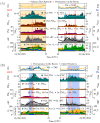Real-Time Measurements of Indoor-Outdoor Exchange of Gaseous and Particulate Atmospheric Pollutants in an Urban Area
- PMID: 37835093
- PMCID: PMC10572255
- DOI: 10.3390/ijerph20196823
Real-Time Measurements of Indoor-Outdoor Exchange of Gaseous and Particulate Atmospheric Pollutants in an Urban Area
Abstract
Air pollution is one of the greatest environmental risks to health, causing millions of deaths and deleterious health effects worldwide, especially in urban areas where citizens are exposed to high ambient levels of pollutants, also influencing indoor air quality (IAQ). Many sources of indoor air are fairly obvious and well known, but the contribution of outside sources to indoor air still leads to significant uncertainties, in particular the influence that environmental variables have on outdoor/indoor pollutant exchange mechanisms. This is a critical aspect to consider in IAQ studies. In this respect, an experimental study was performed at a public site such as a university classroom during a non-academic period in Madrid city. This includes two field campaigns, in summer (2021) and winter (2020), where instruments for measuring gases and particle air pollutants simultaneously measured outdoor and indoor real-time concentrations. This study aimed to investigate the dynamic variations in the indoor/outdoor (I/O) ratios in terms of ambient outdoor conditions (meteorology, turbulence and air quality) and indoor features (human presence or natural ventilation). The results show that the I/O ratio is pollutant-dependent. In this sense, the infiltration capacity is higher for gaseous compounds, and in the case of particles, it depends on the particle size, with a higher infiltration capacity for smaller particles (<PM2.5). Additionally, under specific situations of high atmospheric stability, the concentrations of gases derived from traffic tend to accumulate in the room, keeping the background concentrations. These concentrations decreased when room ventilation was produced simultaneously with well-ventilated (high wind speed) external conditions. This suggests that the meteorology and turbulence parameters played a key role in influencing indoor ambient pollution conditions by enhancing the dispersion or accumulation of pollutants. The obtained results highlight the high number of variables involved in the outdoor/indoor exchange of air pollutants and, consequently, how complex its study is. Thus, the knowledge of these factors is critical for understanding the behavior of indoor pollutants and controlling human exposure in indoor environments.
Keywords: gaseous and particulate pollutants; indoor activities; indoor air quality (IAQ); real-time I/O measurements; urban air pollutants.
Conflict of interest statement
The authors declare no conflict of interest.
Figures








References
-
- WHO . Air Quality Guidelines: Global Update 2005: Particulate Matter, Ozone, Nitrogen Dioxide, and Sulfur Dioxide. World Health Organization; Geneva, Switzerland: 2006. - PubMed
-
- World Health Organization Air Pollution. [(accessed on 4 July 2023)]. Available online: www.who.int/health-topics/air-pollution.
-
- WHO . WHO Global Air Quality Guidelines: Particulate Matter (PM2.5 and PM10), Ozone, Nitrogen Dioxide, Sulfur Dioxide and Carbon Monoxide. World Health Organization; Geneva, Switzerland: 2021. - PubMed
-
- EEA . The European Environment—State and Outlook 2010: Assessment of Global Megatrends. European Environment Agency; Copenhagen, Denmark: 2011.
Publication types
MeSH terms
Substances
LinkOut - more resources
Full Text Sources
Medical

